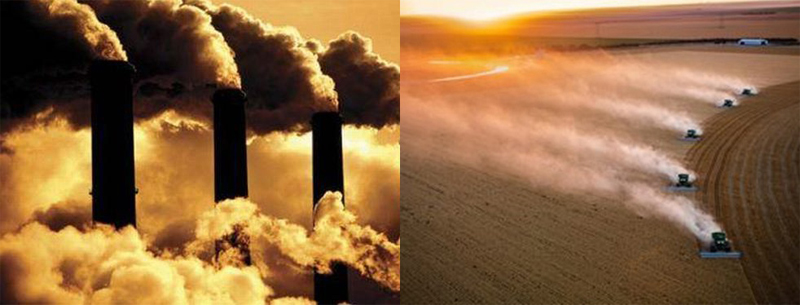What are greenhouse gases?
GHG, known as greenhouse gases, are those gases that build up in the Earth’s atmosphere and are able to absorb the infrared radiation from the Sun, increasing and retaining heat in the atmosphere. In other words, they are those gases present in the atmosphere that lead to the greenhouse effect.
Of the solar radiation that reaches the planet, 1/3 is reflected to space and the rest absorbed by the different layers of the planet (hydrosphere, lithosphere, atmosphere). Radiation coming from the Sun is long-wave, whereas the radiation that the Earth reflects is a short-wave, infrared type (gives off heat); part of this heat is absorbed by certain greenhouse gases (GHG), critical to the development of life on Earth.
The main greenhouse gases are of natural origin, and are essential for life on the planet, because thanks to them we benefit from the sun heat and help the increase of the temperature of the air that is closer to the ground, so that the planet’s temperature is adequate for life on it. The average temperature of the planet is 15 ° C, and if there were no GHGS it would be – 18 ° c.
The critical phases of greenhouse gases are measured by its GWP (Global Warming Potential) or their capacity of radiation absorption.The most important greenhouse gases are: water vapour, carbon dioxide (CO2) methane (CH4), nitrous oxide (N2O) CFCs (CFC) and ozone (O3), and sulfur hexafluoride. This is the GHG with greater warming potential: 22,000 to Co2 which is 1. But the best known is the CO2, because their contribution to the greenhouse effect is greater than that of the rest when we abide by gases emitted directly by human activity.
What is the problem? Its cause? And the consequences? Global warming and climate change. Acidification of the oceans.
The problem arises when the GHG concentration level increases, causing the average temperature to increase worldwide which is more than what would be expected if there were no such man-made GHGs.

Why does it increase?
One major cause is human activity. We emit greenhouse gases in a variety of forms: increased use of fossil fuels, greater energy demand, intensive livestock and agricultural production, uncontrolled landfills, and cooling gases are the main causes of GHG emission. Also, the massive destruction of forests generates loss of natural CO2.
Global warming and climate change
We do not need this excess heat, or Global warming,caused by the increase in the concentration of greenhouse gases in the atmosphere, which raises temperatures even though they are apparently few degrees, these small changes in temperature they involve dangerous changes in the climate (climate change), causing droughts in some places and in others rains. These are extreme weather events.
In addition, methane CH4 (PGC 21) is trapped from million years ago in the permafrost (permafrost) at surface levels of the ground in very cold regions, and there is a danger of release of high concentrations of methane CH4 (PGC 21) held under the ice, because it is escaping the frozen region though bubbles in the Arctic at a higher rate than expected and desired.
What is the acidification of the oceans?
Carbon dioxide builds up not only in the atmosphere (Global warming), but also in the oceans, lowering its the PH level.
The burning of oil, coal or gas, quickly changes the basic chemistry of the oceans, which makes the water more acidic, thus affecting marine life.
Paris Summit on climate change (COP21)
The Paris Summit was held in December 2015, and an agreement against global warming was reached, the first “historical universal agreement of climate negotiations”according to the French President, François Hollande.
The main objectives include:
- • Greenhouse (EGEI) GHG emissions to stop rising, start reducing them, and to reach a balance between emissions caused by human activities and emissions which can be neutralized by natural or technological means.
- • To maintain the Earth’s temperature well below the 2 ° C with respect to the pre-industrial era and continue our efforts to limit the increase to 1.5 °C
Author: Department of Environment of Bester


Leave A Comment